Measuring Body Fat
Segmental analysis sounds a bit hi-tech, but it really means how fat is distributed around the body in simple English. This article is all about the machine and what data can be extracted. I looked forward to learning how lean I was or not. Having a scientific background, measurements, and statistics intrigue me. I admit I have a bit of a midriff stomach excess and had already done a crude measurement. This suggested I had about 15% body fat. Was my measurement accurate? Does fat matter to us apart from looking better for low fat? Are we at risk for our health if we carry weight? It would be quite reasonable for the average reader to ask, are these questions for real?
The information booklet from the InBody site was helpful, and the type of kit is illustrated above. The handles are gripped with the palms. You have to stand on two shiny plates to improve skin contact. It is easy to wonder if this works on the basis of the electric chair, given the word electrical appears in the bumph! Fortunately, this is all painless. Using a password, I could compare it to measurements later on and see if I could meet my goals. Of course, the goal I am aiming for is to reduce my body fat. Height is measured in (cms). I seem to have dropped a couple of centimetres. My age is added. The brochure shows a svelte woman without an ounce of fat or should I say gram! Why do they do that – show people young, fit, beautiful in their prime? I want to see people like me, or indeed, as the image is shown at the front of this article!
My centre tells me the following
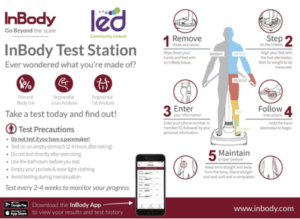
https://www.ledleisure.co.uk/inbody
The Inbody is a Bioelectrical Impedance Analysis Machine, but what does this mean?
- BIA is a method of assessing body composition
- Inbody uses BIA- small electrical current flows through the body
- Resistance (impedance) is measured to calculate body composition
- Different resistance to Body Water, Skeletal Muscle Mass, Body Fat
How accurate is this data?
I am left wondering, how accurate is this? Has it been calibrated? What are the variables and tolerances? These are all the types of questions I have been trained to ask. The equipment is about 98% accurate. Who says this? The makers, of course! Oops, that’s called bias. While it is one of the most accurate body scanners on the market, its findings shouldn’t be taken as gospel. As with all measuring tools, there are surrounding factors that can influence the reading taken at the time. source link. The Mayo Clinic and Dr Edward Laskowski say…
Although the technology is improving, it’s hard to get an accurate body fat measurement from most available commercial body fat analyzers. Various types of body fat analyzers — also called impedance meters — are available to the general public. Results from portable body fat analyzers can vary, though. Your body fat measurement can depend on many factors such as the device’s quality and how hydrated you are when you have the measurement.
What’s the score?
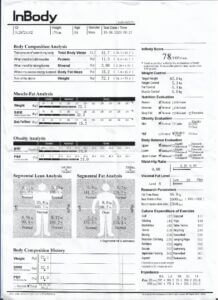
InBody chart for author
Body fat and segmental analysis distribution
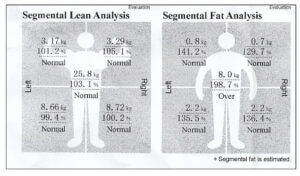
Body Fat and Segmental Analysis
Body fat and segmental analysis identify how many pounds of lean mass are in each body segment through Segmental Lean Analysis. I use this section to look for any imbalances between corresponding segments (e.g. Right Arm, Left Arm) according to the brochure. When I look at mine, I am ‘normal’ but have a shade less on my right side. In the arms, my left side is down by 0.12kg and my left leg 0.06kg. This suggests less muscle mass. I am right-handed, so this may account for right dominance. The left side could be down to dominance, but as I have injured my right knee, the muscles on that side should be less than those on the left side. These differences are far too small to impose an accurate interpretation.
Other information
While the BMI measurement has its critics, the waist-hip ratio is often regarded as better. The value represents the amount of fat in the waist, hips, and buttocks. So, how is it calculated? Healthline suggests this.
To measure it yourself:
- Stand up straight and breathe out. Use a tape measure to check the distance around the smallest part of your waist, just above your belly button. This is your waist circumference.
- Then, measure the distance around the most significant part of your hips — the widest part of your buttocks. This is your hip circumference.
- Calculate your WHR by dividing your waist circumference by your hip circumference.
Now, my WHR is 0.88, so I thought I would measure it and see how close I was. I had my wife measure both, which came out at 90cm, which would equate to a ratio of 1.0. Given the World Health Organisation guide, 0.9 or less is healthy.
Basal Metabolic Rate
My visceral fat is undoubtedly around my waist, and this is where most fat lies in all of us and around the hips. Moving onto metabolic rate, my basal metabolic rate measures (BMR) 1600 Kcals, with a range of 1561 – 1826 Kcals. My recommended daily calorie intake is 2344 Kcals. My estimate has always been around 2400 for non-active work.
The Basal metabolic rate is the energy in calories required to allow your body to function at rest. If you exercise, you will need more. A male undertaking heavy physical work may need 4000 Kcals a day. If one went on a polar trek, the calories required would increase up to 6000 Kcals per day, which seems extraordinary. If we eat more than we need, we will store excess energy in fat and muscle. This is unhelpful if you don’t need the energy.
Using an online calculator, I decided to check this against a typical calculator found on the internet. The BMI was 25 versus 24.9. My daily Calorie requirements were 2239 versus 2344 and the BMR was 1473 versus 1600 Kcals. My body fat percentage was 24 versus 21%.
Typically, the shape illustrated would be classed as morbidly obese, and the BMI or body weight mass index would be at least 32 – 35. Patients who consulted me were told they could not have any treatment for their painful feet because they were overweight. In order to reduce their pain, they needed to lose weight. They could not lose weight because their feet were sore. I argued with one of my healthcare units that it seemed self-defeating to impose a BMI target, but it was a rule imposed within the NHS from up high! Mind you, if you paid privately, the same rules did not apply!
Obesity
The term for being medically overweight is obesity. The NHS site is helpful and explains why being overweight is not good for our health. It also provides a link to help people exercise, so it is worth looking at.
- eat a balanced calorie-controlled diet as recommended by a GP or weight loss management health professional (such as a dietitian)
- join a local weight loss group
- take up activities such as fast walking, jogging, swimming or tennis for 150 to 300 minutes (2.5 to 5 hours) a week
- eat slowly and avoid situations where you know you could be tempted to overeat
You may also benefit from psychological support from a trained healthcare professional to help you change your thoughts about food and eating.
Conclusion
I have looked at my own body fat and segmental analysis helped by equipment marketed as InBody. This has offered me an idea of how my segmental analysis shows me how lean I am. The data have provided ideas about my calories and basal metabolic rate. I know I am slightly on the heavy side and carry a small amount of extra fat reserve that I don’t need. I know my cholesterol levels are somewhat higher than ideal, and my liver has fat around it, as seen from scans. My blood pressure and heart rate are not bad, and I can exercise reasonably well, but I have a few breathing difficulties. Using the gym is essential and will continue to be part of my life, but without a doubt, I need to balance my nutritional needs.
Thanks for reading ‘Body Fat and Segmental Analysis’ by author David R. Tollafield.
David is a former podiatrist and now a full-time author and blogger, as well as a fiction writer under RCBlyth.com
Why not read Foot Health Myths Facts & Fables available from Amazon books
Published by Busypencilcase Communications &b Publications. Est. 2015 for ConsultingFootPain
Modified January 2025


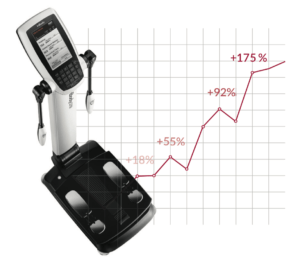
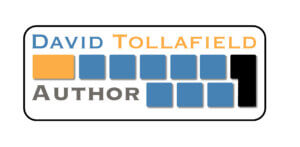
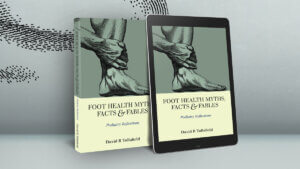
Recent Comments